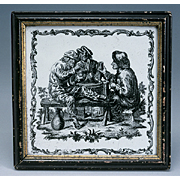| Maker(s): | Sadler, John and Green, Guy (probably)
| | Culture: | English
| | Title: | tile: three peasant men drinking
| | Date Made: | 1765-1775
| | Type: | Architectural Element; Household Accessory
| | Materials: | ceramic: tin-glazed earthenware, transfer print, overglaze black enamel, paper; wood, paint, gilding
| | Place Made: | United Kingdom; England; Liverpool
| | Measurements: | framed - 5 5/8 x 5 5/8 x 5/8 in.; 14.2875 x 14.2875 x 1.5875 cm; tile - 4 5/8 x 4 5/8 in,
| | Accession Number: | HD 91.167
| | Credit Line: | Museum Collections Fund
| | Museum Collection: | Historic Deerfield
|
|

|
Description:
English delft tile enclosed in a 19th century molded frame painted black and gold, which the donor noted: "Printed. Three Peasants Carousing. Teniers subject. Ray 713 88 border" and "Not in Hodg." and "From house built by Gen. Josep Palmer at Germantown, Quincey etc." There is an inscribed piece of paper Inscription on back of tile that reads: “This Tile / was taken from a fire-place / ornamental setting, in the / house built by Gen. Joseph / Palmer at Germantown, /Quincy, about the year 1750./ The house was moved and at-/ tached to the Snug Harbor buil-/ ding in 1868./ Gen Palmer was the grand-/ father of the paternal grand-/ mother of Mrs. Ellen E. (Peabody) / How, to whom the Tile is pres-/ ented, this 13th May, 1870.” The tile was taken from a house built by General Palmer (1716-1788), who came to Massachusetts from England in 1746; he set up a glassmaking plant in partnership with his brother-in-law in the Germantown section of Braintree (now Quincy) and also operated a chocolate mill and manufactured spermaceti candles. In 1774 and1775, Palmer served in the contentious Massachusetts Provincial Congress and the Cambridge, Massachusetts, Committee of Safety. He later received a commission as a colonel in the Massachusetts militia, ranked as a brigadier in his own Suffolk County militia, and given his own command of troops in 1777. Following the war, Palmer returned to business as a salt manufacturer; he built a large country residence known as “Friendship Hall,” famed for its hospitality, refined furnishings, and beauty, with grounds that contained a fruit garden, nursery of trees, large poultry yard, and flower garden. This tile is decorated with a black transfer-printed scene of three peasant men drinking and smoking around a small table and with a jug of wine on the ground, with a '88' border of raffles and scrolls. This transfer-printed scene was based on a print engraved by the artist David Teniers (1610-1690). John Sadler (1720-1789), a Liverpool printer, and Guy Green, his assistant and partner by 1761, were innovators in the application of printing methods to pottery. In 1756, both swore an affidavit that they “did within the space of six hours … print upwards of Twelve hundred Earthen Ware Tiles of different patterns, at Liverpool” and claimed that their tiles were “neater than one hundred skilful pot painters could have painted in the same space of time in the common and usual way of painting with a pencil.” Unlike the wood block printed tiles mentioned in the affidavit, this tile’s decoration employs bat transfer printing. This method involved transferring the image on an engraved copperplate to the glazed surface of a tile with a gelatinous glue bat. This method involved coating an engraved copper plate with a layer of tacky oil and then removing the excess; using a gelatinous glue bat to pick up the oil droplets on the plate, which were then applied to the tile’s glazed surface; dusting black enamel onto the tile, which adhered to the sticky oil transferred from the bat; and firing the tile to melt the enamels into the glaze.
Link to share this object record:
https://museums.fivecolleges.edu/detail.php?t=objects&type=ext&id_number=HD+91.167 |